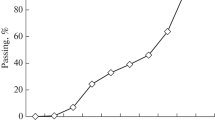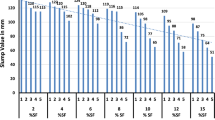Abstract
Nondestructive testing of concrete is preferred due to its distinct advantage over conventional compression tests. The evaluation by nondestructive methods of the actual compressive strength of concrete in existing structures is based on empirical relations between strength and nondestructive parameters. The aim of the study was to investigate the effects of different types and dosages of mineral admixtures on the correlation between ultrasonic pulse velocity (UPV) and compressive strength for self-compacting concrete (SCC). Different proportions of fly ash (FA) and silica fume (SF) are used as the mineral admixtures in replacement of portland cement (PC) in SCC. The work focused on concrete mixes having a slump flow between 700 and 710 mm. Specimens were prepared and cured in standard 20 ± 3°C water for periods of 3, 7, 28, and 130 days. At the end of each curing period, compressive strength and UPV were determined. Tests were carried out on 150-mm cubic specimens to evaluate the compressive strength and UPV of SCC. The results of this research indicate that reductions in the compressive strength due to SF were lower than those for FA at all levels of replacement at 3 days, while both UPV and compressive strength at early ages were very low at all levels of mineral admixtures. However, with the increase of the curing period, both UPV and compressive strength of SCCs containing both FA and SF increased. The correlation between UPV and compressive strength is also exponential for SCCs containing both FA and SF. However, constants for each pozzolana were different for each level of replacement of PC in SCCs.
Similar content being viewed by others
References
Ozawa, K., Maekawa, K., Kunishima, M., and Okamura, H., High Performance Concrete Based on the Durability of Concrete, in The Second East-Asia and Pacific Conference on Structural Engineering and Construction, Prof. Fumio Nishino, Ed., Thailand: Chiang Mai, 1989, pp. 445–450.
Concrete Society, Self-Compacting Concrete-Concrete Society Information Sheet, Concrete, 2001, vol. 35, no. 1, pp. 1–4 (suppl.).
Filipczynski, L., Pawlowski, Z., and Wehr, Z., Ultrasonic Methods of Testing Materials, London: Butterworth, 1966.
Krautkramer, J. and Krautkamer, H., Ultrasonic Testing of Material, New York: Springer-Verlag, 1983.
Komlos, K., Popovics, S., Nurnbergerova, T., Babal, B., and Popovics, J.S., Ultrasonic Pulse Velocity Test of Concrete Properties as Specified in National Standards, J. Cem. Concr. Compos., 1996, vol. 18, pp. 357–364.
Lin, G., Lu, J., Wang, Z., and Xiao, S., Study on the Reduction of Tensile Strength of Concrete Due to Triaxial Compressive Loading History, Mag. Concr. Res., 2002, vol. 54, no. 2, pp. 113–124.
Grosse, C.U. and Reinhardt, H.W., New Developments in Quality Control of Concrete Using Ultrasound, Proc. the International Symposium on NDT in Civil Engineering (Berlin, 2003), www.ndt.net/article/ndtce03/papers/v087/v087.htm.
Blitz, J. and Simpson, G., Ultrasonic Methods of Non-Destructive Testing, London: Chapman and Hall, 1996.
Nehdi, M., Chabib, H.E., and Naggar, A., Predicting Performance of Self-Compacting Concrete Mixtures Using Artificial Neural Networks, ACI Mat. J., 2001, vol. 98, no. 5, pp. 394–401.
Galan, A., Estimate of Concrete Strength by Ultrasonic Pulse Velocity and Damping Constant, ACI J. Proceedings, 1967, vol. 64, no. 10, pp. 678–684.
Rajagopalan, P.R., Prakash, J., and Naramimhan, V., Correlation between Ultrasonic Pulse Velocity and Strength of Concrete, Indian Cone. J., 1973, vol. 47, no. 11, pp. 416–418.
Lin, Y., Lai, C.P., and Yen, T., Prediction of Ultrasonic Pulse Velocity in Concrete, ACI Mat. J., 2003, vol. 100, no. 1, pp. 21–28.
Tharmaratram, K. and Tan, B.S., Attenuation of Ultrasonic Pulse in Cement Mortar, Cem. Concr. Res., 1990, vol. 20, pp. 335–340.
Demirboga, R., Türkmen, İ., and Karakoç, M.B., Relationship between Ultrasonic Velocity and Compressive Strength for High-Volume Mineral-Admixtured Concrete, Cem. Cone. Res., 2004, vol. 34, no. 12, pp. 2329–2336.
EFNARC. European Guidelines for Self-Compacting Concrete. Specification and Production and Use, UK: Association House, 2005, www.efnarc.org.
ASTM C 39-96, Standard Test Method for Compressive Strength of Cylindrical Concrete Specimens, Annual Book of ASTM Standards, 1998.
ASTM C 597-97, Standard Test Method for Pulse Velocity through Concrete, Annual Book of ASTM Standards, 1998.
Demirboga, R., Thermo-Mechanical Properties of Sand and High Volume Mineral Admixtures, Energy Build, 2003, vol. 35, no. 5, pp. 435–439.
Demirboga, R., Örüng, I., and Gül, R., Effects of Expanded Perlite Aggregate and Mineral Admixtures on the Compressive Strength of Low-Density Concretes, Cem. Cone. Res., 2001, vol. 31, pp. 1627–1632.
Wong, Y.L., Lam, L., Poon, C.S., and Zhou, F.P., Properties of Fly Ash-Modified Cement Mortar-Aggregate Interfaces, Cem. Cone. Res., 1999, vol. 29, pp. 1905–1913.
Caliskan, S., Aggregate/Mortar Interface: Influence of Silica Fume at the Micro-and Macro-Level, Cem. Cone. Comp., 2003, vol. 25, no. 45, pp. 557–564.
Roy, D.M., Fly Ash and Silica Fume Chemistry and Hydration, ACI, SP-114, 1989, pp. 117–138.
Nassif, H. and Suksawang, N., Development of High-Performance Concrete for Transportation Structures in New Jersey, Final Report, 2003, p. 115.
Author information
Authors and Affiliations
Corresponding author
Additional information
The text was submitted by the authors in English.
Rights and permissions
About this article
Cite this article
Ulucan, Z.Ç., Türk, K. & Karataş, M. Effect of mineral admixtures on the correlation between ultrasonic velocity and compressive strength for self-compacting concrete. Russ J Nondestruct Test 44, 367–374 (2008). https://doi.org/10.1134/S1061830908050100
Received:
Published:
Issue Date:
DOI: https://doi.org/10.1134/S1061830908050100




